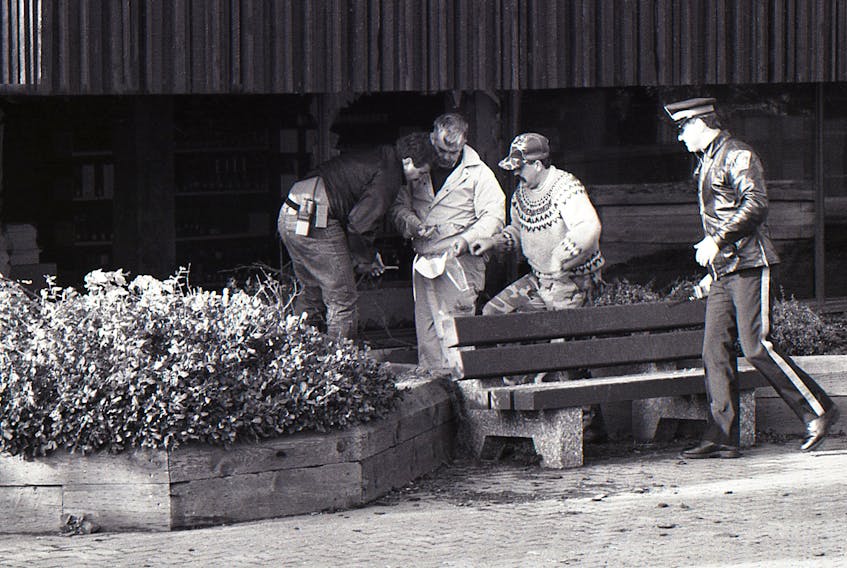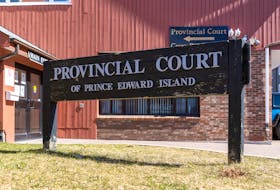CHARLOTTETOWN, P.E.I. - Charlottetown Deputy Police Chief Brad MacConnell says the most striking reverberations from the four bombs set by Roger Bell was the resounding rattling of nerves across Prince Edward Island.
There were no fatalities resulting from the reign of terror orchestrated by Bell, a native of Murray River who would teach high school chemistry for many years before suddenly resigning his job at Bluefield High School in 1982.
One person was injured in the Province House blast on April 20, 1995, but that was the extent of human physical cost from four bombing incidents that spanned nearly a decade.
Bell’s bombing campaign, MacConnell notes, hit hardest on a psychological level.
“When I look at the Loki 7 (Bell’s calling card that drew on Norse mythology) bombings, it was what cost Prince Edward Island its innocence,’’ he says.
“No longer did these things happen in other places. They were happening here. It had a grasp on the community – fear that was tangible. You could sense it in people.’’
RELATED: How Loki 7 bomber Roger Bell became a police task force’s top priority

Tips poured in from the public, some pointing fingers at family members, others suggesting neighbours should come under police scrutiny.
“It was making people very suspicious,’’ says MacConnell, who would later play a role in bringing Bell to justice.
“No one really knew who was responsible. So, there was really a lot of chatter in the community.’’
Bell’s first blast was 30 years ago on Oct. 10, 1988 with a home-made pipe bomb exploding in a flower bed in front of the Provincial Law Courts building in Charlottetown.
He would not strike again until July 9, 1994 when he set off an explosion in a garbage can in Point Pleasant Park in Halifax.
One year earlier, Bell’s name surfaced in the course of the investigation into his first bombing in Charlottetown.
Canada Customs found books on how to make and detonate explosives had been ordered by a man named Roger Bell of Charlottetown.

Attempts by police to talk to the reclusive welfare recipient in 1993 proved futile. With no grounds for a warrant, police relegated Bell to a list of suspects.
Bell struck again in 1995 with the legislature bombing that not only unnerved Islanders but drew attention south of the border.
Randy Currie, who would join forces with MacConnell and five other officers on a task force that would eventually corral Bell, heard the explosion – a loud bang that sounded like a dump truck’s heavy metal door slamming shut – and raced to the scene.
Currie, who retired earlier this year after 35 years with the Charlottetown Police Services, immediately took charge of crowd control.
He clearly recalls the FBI calling police in the capital city the day of the bombing, which was just one day removed from the Oklahoma City bombing that saw a truck packed with explosives detonated outside the Alfred P. Murrah Federal Building, leaving 168 people dead and hundreds more injured.
A bomb planted at the Speedy Propane bulk plant in Charlottetown on June 26, 1996 was bigger than the first three Bell set but failed to detonate on its own. A police bomb squad safely detonated the sinister weapon.
MacConnell says the pressure to catch the bomber was intense.While this bomb did no physical damage, it proved to be the fuel for the formation of a joint task force drawing from the city police and the RCMP.
“We were the guys that were tasked to bring this to closure,’’ he said.
“There was no one else. It was us.’’
A tip from a man who recalled Bell as a teenager was into Norse mythology (the Loki link) and exhibited a fascination with explosives brought Bell into high consideration as the potential bomber.
Surveillance of Bell for three days proved uneventful but the following day he was spotted observing the commotion caused by a bomb threat that had been called into the Confederation Library in Charlottetown.
The call was traced to a public phone in a store just a short stroll from where Bell lived in an apartment on Longworth Avenue.
“That was a significant turn of events,’’ said MacConnell.
The task force would then literally focus on Bell around the clock, setting up surveillance shop above a funeral home located across the street from Bell’s apartment.
Jerry Woolfrey, a retired RCMP staff sergeant, coordinated the task force along with Mike Quinn, a former detective with the Charlottetown Police.

Woolfrey says there were always two officers watching Bell at all times. He was followed every time he left his apartment.
“Once we started doing surveillance on him we considered him a prime suspect at that point but we didn’t have enough evidence to affect an arrest or a warrant or anything at that stage,’’ he says.
“But certainly from a management perspective it was very nerve-racking thinking about the possibilities. Could he be in the building making another bomb?’’
Police mitigated that possibility by using warrants to enter the apartment when Bell was out to see if there was any evidence that he was making another bomb.
Cameras and listening devices were also installed in the apartment.
Day after day, week after week, task force members spent eight-hour shifts watching and listening to Bell’s every move.
“He was very quiet and essentially a loner at that point in his life which made it very difficult for us because once we started doing surveillance later on he basically made contact with nobody ever beyond making a purchase at a store,’’ said Woolfrey.
“Even his family really didn’t know what he was up to. He was on an individual mission.’’
In December, 1996 two members of the task force entered Bell’s apartment and made an arrest long sought by edgy Islanders.Increasingly incriminating evidence mounted through good, old roll-up-the-sleeve police work, rooting through Bell’s garbage, calling in handwriting experts and scanning through Maritime plumbing stores.
MacConnell, who drove Bell to jail, saw in the bomber’s face a clear look of defeat.
“He was at that stage (that seemed to say) ‘I didn’t see this coming and now my life has changed forever,’’’ he says.

Currie, though, believes Bell may have felt police were closing in.
One day while in jail, Bell told Currie ‘you guys left a calling card’’ suggesting he knew police had been in his apartment.
What police found in his apartment after a thorough search following the arrest was hold-up notes. A gun was found hidden in Bell’s car. During surveillance, Bell was viewed on a few occasions parked outside a bank.
Currie believes Bell was planning to rob a bank and “get out of Dodge.’’
Bell, in the end, would plead guilty and be sentenced to 10 years in jail less one year credited for time already served.
MacConnell believes Bell felt he was too smart to get caught.
“Roger was extremely intelligent, but his intelligence fed into his arrogance,’’ he says.
“What a true waste of an exceptional mind…by all accounts of anyone we talked to, he was extremely remarkably intelligent.’’
Currie also acknowledges Bell’s intelligence but offers a less flattering description of the man.
“He was sort of a pathetic character, but dangerous."
- Randy Currie
Both Currie and MacConnell agree that Bell most likely would have struck again had he not been caught.
“I think Roger would eventually have set off another bomb,’’ says MacConnell, who was last advised that Bell, now 74, was living alone in Halifax with no issues to report.









